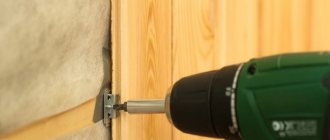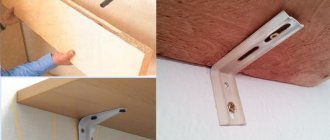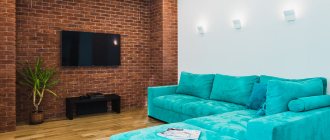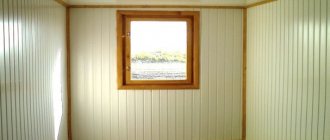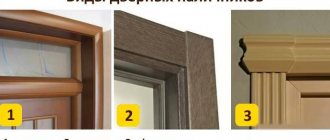The personal hell of a perfectionist is a bunch of wires going down from a TV hanging on the wall. This problem can be dealt with in different ways, including very creative ones. The main question is: at what stage will you do this? We will tell you about all the options: from complex ones to those that can be dealt with within an hour.
Ways to hide wires:
- Inside the wall
- Using a decorative panel
- In a box
- Make them part of the decor
- Use furniture
What is gating and what are its disadvantages?
A groove is a channel or recess made in the walls specifically for laying wires. This method allows you to make the wiring completely invisible to the eye. However, gating has several serious disadvantages.
Disadvantages of gating:
- Damage to plaster. Craftsmen rarely manage to create smooth channels. But even with quality work done, it is necessary to restore the final layer of plaster. If you groove the walls after renovation, you have to spoil the finish - after it you need to completely change the wallpaper, or even the covering on the ceilings, since it happens that the grooves run along the ceiling.
- A lot of dust. When channels are knocked out in the walls, construction dust is intensively formed, which spreads throughout the home. If the gating is not carried out during the initial arrangement of the premises, then after it you have to do the repairs again - update the walls and ceiling.
- Noise. The chipping is done with a hammer drill, which creates a lot of noise that annoys neighbors even if the work is carried out during the hours permitted by law.
- Lack of access. The wiring is completely hidden and there is no easy access to it. If the wires are laid in grooves, then replacing the wiring is only possible by laying a new wire and disconnecting the old one (at both ends).
An alternative to gating, which tightly hides the wiring, is open methods of laying cables.
Make them part of the decor
Yes, if it’s too late to come up with global restructuring, you can get out of it in a more creative way. Don't hide the wire, but decorate the room with it! Sounds weird? Maybe, but it looks great. So wires can become part of a futuristic interior if they are mounted on the wall along with the equipment. An excellent option for the room of a teenage boy who is interested in computer games. With interesting lighting the effect will only increase.
Also, the wires themselves can be hidden inside metal pipes. And the pipes will perfectly complement the loft style. Don't be shy about using items that have already been used. They will only add charm to the interior. In general, the lack of large funds to solve this issue is not such a big problem. You just need to use your imagination.
On the Internet you can find a proposal to “disguise” the wires as wood. To do this, you need to draw a trunk and branches on the wall with black paint and attach the wires to their background. According to the plan, they should no longer be conspicuous. But we wouldn't recommend using this method if you don't have a penchant for drawing.
Another option is not just to draw a tree, but to make it 3D. That is, stick colored figures of birds, leaves and flowers on the wall. Such sets can be found on the Internet or cut out yourself. This idea is best suited for children's rooms.
What to consider when choosing wire camouflage?
When choosing a method for laying (masking) electrical wires, take into account their technical features and length.
Please note the following restrictions:
- laying cables along the walls and along the ceiling is unacceptable;
- It is important that there is no heavy load on the plug near the equipment, otherwise the connector may break;
- It is forbidden to work with wires without insulation; during operation, the cable may be damaged and its insulation may be compromised;
- Areas with chips, cuts and cracks must be insulated with electrical tape, or the damaged section of the cable must be replaced with a new one.
When choosing a cable installation option, consider the following points:
- Total length and number of wires. If we are talking about one or two wires, then you can make recesses for them or buy cable channels. If there are a lot of wires, it is easier to hide them behind plasterboard panels.
- Location of wires. If the installation is on the ceiling, you will need a longer wire than when laying on the floor.
- Distance to sockets. If the equipment to which you need to connect the wire is located near sockets, it is recommended to disguise it.
- Safety. If there are children or pets in the home, the wires must be positioned so that any contact with them, accidental or intentional, is excluded. The cable should be placed in an inaccessible place - for example, in a wall or in a special box.
Cable channels
The device is designed to help disguise wires and properly organize communications if it is impossible to hide them under the baseboard or wall cladding. First, secure the hollow structure in a convenient way along the path of the cords; for this you can use tape, mounting tape, or clamps. Then pass the wires through the cable channels and connect to the network.
Related article: 6 most current types of sofas for a fashionable interior
For vertical communications, cable channels for 2-4-5 wires are provided . The structure is attached to the wall with self-tapping screws. If necessary, it is easy to remove the panel and insert another wiring into the cavity. Another type of product - “system tubes” - allows you to equip an original system for masking communications by putting together a structure of the required size from tubular elements 20 cm long.
Options for laying wires without gating
Often, new equipment is connected, leaving the wires lying on the floor or hanging on the walls. It looks unsightly, spoils the interior, and, moreover, creates the danger of equipment falling or a person tripping over scattered wires.
If a major renovation is being done in the house, then all the wires are laid in the walls - in grooves. If the house is wooden, the wires are usually hidden in protective corrugated sleeves. You can place the wires on one of the “edges” of the room - on the walls, floor or ceiling. Let's take a closer look at these options.
Floor
Sometimes you need to run wiring across the floor. This is easier to do than on the walls. If the installation is carried out after repairs, naturally no one will want to cut grooves in the cement screed. We need to look for more affordable installation methods.
The best option for laying wires on the floor without gating:
- In special skirting boards with holes. Construction stores offer a wide range of similar products. The wires are laid in the plinth, removing the removable element. After installation, the “valve” is returned to its place.
- Under laminate. To implement this option, the lamellas under which the cable will be passed are partially removed - right up to the construction joists. The wire is laid in a corrugated pipe. If necessary, space is cut into the wood for the wires to cross.
Ceiling
The choice of installation option on the ceiling depends on the type of ceiling covering. Stretch ceilings are often installed in residential premises and offices. They “eat up” excess space, but allow you to distribute them at the top as required by the electrical supply diagram.
There are no obstacles for cables on the ceiling and they can be laid there along the shortest path, this allows:
- reduce costs;
- reduce work completion time;
- reduce the overall circuit resistance;
- ensure a higher level of fire safety;
- if necessary, it is easy to replace the wires.
According to fire safety requirements, cables must be covered with corrugated pipes. The same should be done with wiring installed behind suspended ceilings, in niches or plasterboard structures.
It is recommended to connect all the wires into one trunk - this will simplify future repair work. If the ceilings are concrete, you can’t do without gating.
Walls
The cable on the wall can be placed in a decorative box - this option is especially good for large-diameter wires, since there is no way to hide them in the wall without repairs.
Other options for laying wires on the walls:
- hide in door frames;
- cover with baguettes or moldings;
- lay in the window slopes.
Please note that the last three options are only suitable for low-current wires (Internet, telephone, etc.). High voltage wires may be laid in accordance with fire safety standards.
Box
It is worth emptying the top drawer of the table from various items and using it to store cords and wires. A bedside table with an extension cord hidden inside is also good for these purposes. This is an excellent functional device for charging gadgets.
To do this, you need to buy a bedside table with existing holes or make them yourself, and then stretch the cords from the extension cord into it.
Blue is a reliable color: how people dye their hair, depending on their personality type
Daughter is daddy's love: Yulia Savicheva spoke about her relationship with her father
Cake “Stripe” with butter cream and vanilla pudding: a no-bake dessert
Various methods of disguise
There are a large number of methods for laying and masking wires, which differ from each other in labor intensity, aesthetics, safety and other features. The only thing they have in common is that they do not require gouging out recesses in the walls (gouging).
Corrugated sleeve
This rigid pipe not only protects wires from various types of damage, but has a number of other advantages.
Advantages of corrugated pipes:
- flexibility - the product can be easily installed in rooms of different configurations;
- protect wires from electromagnetic influence of various emitters;
- protect the room from the induced electromagnetic field that occurs when alternating current passes through the wires.
The big disadvantage of corrugated sleeves is the low aesthetics of this product. It is more suitable for technical rooms and looks extremely unnatural in living rooms. In the latter case, you have to resort to additional decoration - if the sleeve is stretched in a visible place.
The corrugated pipe does not hold its shape well, so it will be located parallel to the floor surface if it is fixed to the ceiling or floor. Typically, corrugated hoses are used when it is necessary to collect all the cables in one bundle. This format is rarely used in residential premises.
Flat cable
A flat cable, which is quite simply attached to the wall, and then sealed with a thin layer of plaster, allows you to do without gating.
In order to avoid mistakes when carrying out work, it is recommended to sketch out a small diagram in advance - exactly how the wires will pass, where the sockets and switches will be located.
The flat cable is secured to the wall using:
- metal ties;
- plastic dowel clamps;
- quick-drying plaster;
- plastic mounting pads.
A drill is usually used to prepare a place for fittings. When the cable is fixed, plaster is applied to the wall - 10 mm thick.
Cable channel
These are plastic boxes, mostly rectangular in cross-section, into which electrical cords are placed. One of the simplest, most convenient, reliable and safe ways to lay cables after finishing.
Cable channels are especially often installed in the kitchen after repairs have been made, and later this or that equipment has been purchased, for example, a washing machine, air conditioning, lighting fixtures.
Features of these channels:
- you can find products of a suitable color - manufacturers produce different options;
- easily replaced and supplemented with new branches;
- made of non-flammable materials;
- reliably protect electrical wiring or other wires from mechanical damage and sunlight.
It is quite difficult to choose cable channels of a suitable color for interiors decorated in ECO, Empire, and Baroque styles. But in any case, laying it in a channel is better than wires hanging on the walls.
To make channel boxes, not only plastic can be used, but also metal - galvanized steel or anodized aluminum.
Possible box section:
- U-shaped;
- W-shaped;
- triangular;
- semicircular.
Boxes to walls or floors are made using self-tapping screws, dowels, iron brackets or anchors. Along with solid options, there are also flexible analogues made of rubber or wire, as well as transparent channels.
Disguise in furniture
Furniture offers great opportunities for masking wires. Behind its vast surfaces you can hide as many wires as you like.
How to hide cables behind furniture:
- fix on the back wall of the cabinet;
- hide behind the table leg;
- secure under the tabletop;
- hide behind a mirror, curtain, vase, large and dense plant.
For fixation, use special holders. You can use reusable plastic clips with Velcro tape. If you are afraid of damaging the surface of the furniture, use regular masking tape. The wires can be disguised by securing them to the back of the tabletop or cabinet.
Use one of the following methods:
- Self-tapping screws. Take fasteners whose length does not exceed the thickness of the tabletop. Typically 3.5x16 mm self-tapping screws are used.
- With double-sided tape. This is not the most reliable option, but it makes it easy to model and adjust the laying pattern.
If you don't want to make holes in your furniture, it is recommended to use perforated screens.
Camouflage covers
You can make a cover for masking wires yourself. It manages to hide several cables at once. The cover is made from plastic bags cut into long strips. They are crocheted into a sleeve into which the wires are threaded. For an extension cord with charges, knit/sew a bag of a suitable size.
In some stores you can also buy plastic covers in the shape of trees, pipes, sparkling snakes. In such designs, unlike cable channels, there are no protective properties; they simply cover the wires, spoiling the aesthetics of the interior.
To make the wires more decorative, you can also purchase spiral braiding - flexible and aesthetic. It can hide either one wire or a whole bunch of them.
Beads and multi-colored electrical tape
With the help of beads and electrical tape, the wire can be transformed into a stylish interior detail. And you don’t even need to pick it up from the floor. It is enough to decorate it with beautiful decor.
Suitable wire decor:
- large beads;
- colored electrical tape;
- textured twine;
- bright threads, etc.
If the wire is thin enough, you can put large beads on it. This technique is often used by designers when creating ethnic motifs. The main thing is to choose the right color of the beads. It should be harmoniously combined with the overall color scheme of the interior.
Decorating with beads will not only give the wire a presentable look, but will also prevent it from wearing out. Thanks to the beads, friction between the wire and the floor will be reduced, so it will last longer.
Installations on the wall
You don’t have to hide the wires anywhere, but on the contrary, put them on display, turning them into an independent art object. To create a “panel” you will need an empty wall. One should be plain, otherwise it will not be possible to achieve the desired decorative effect.
Show your creativity and imagination - create an unusual pattern from wires. To create a stylish installation, you need to carefully consider the contours of the design, otherwise the wire on the wall will look tasteless and shabby.
Recommended installation options:
- abstract images;
- geometric figures;
- silhouettes of houses, etc.
Such installations are inorganic in classic interiors; this solution is suitable for modern design - high-tech, loft, etc. styles.
The wire is bent at a certain angle and fixed to the wall. They should be reliable, but inconspicuous. Before “drawing” a picture from wires, it is first drawn on paper - this simplifies the installation process.
Vinyl stickers
Installations on the walls will look even more interesting if you decorate them with vinyl stickers. They can decorate even a very small piece of wire. The stickers are easy and simple to apply. To ensure they adhere well, they should be applied to smooth, clean surfaces. There are no traces left after the stickers.
You can “draw” a tree using a wire, and vinyl stickers will be its leaves, flowers, and the plinth will pass for soil. Or you can make a separate branch from the wire and place vinyl birds on it. LED garlands, multi-colored ribbons, feathers, etc. will help enhance the effect.
Decorative holders
It happens that there is no free wall in the room to create an installation of wires, then they can be decorated with decorative holders. Structurally, they are ordinary clamps and securely hold the cable.
They differ from ordinary clips only in appearance - they have an interesting design and may contain various decorative elements - leaves, bird figures, etc. Fixation condition - the hole of the clips must fit the size of the cable.
The holders can be replaced with decorative overlays or ties - they will present in a favorable light the most discreet cable stretched along the wall. Thus, a cover imitating a metal pipe will look harmonious in a living room designed in a loft style.
Organizer
If there are a lot of wires concentrated at one point, they can be placed in a plastic box - an organizer. This will eliminate clutter, reduce cleaning time, and increase safety.
There is no need to look for any “suitable boxes”; organizers for wires and all electrical equipment can be bought in the store. These are stylish plastic boxes with ventilation holes and silicone legs.
A variety of elements are placed inside the organizer:
- wires;
- network filter;
- Charger;
- router
But if you wish, you can make such an organizer yourself. An old shoe box or wooden bread box is suitable for this purpose. All you have to do is make holes in them and decorate them to your liking.
A kind of organizer can be made from a cardboard shoe box. To do this, just cut out the side holes in it to let the wires through. This product is suitable for an extension cord to which many wires are connected.
Another solution is to buy a cabinet that has a built-in niche for cables. Or you can dedicate a whole box for wires. You can place an extension cord and gadget chargers there. This will remove the tangle of wires and bring order to the workplace.
Art object
Draw a picture on the wall with a simple pencil. And lay the cable along the drawn outlines. This will allow you to get a picture of wires that matches the design of the apartment.
Disguise behind flowers
The cable is secured to the wall with some kind of clamps. Preferably discreet and transparent. And along the wiring lines, hanging flower stands are installed. Hanging and climbing plants are planted in them. If you don’t want to deal with flowers, you can replace them with artificial analogues.
Masking wires from lamps
Currently, indoor spot lighting is becoming popular. At the same time, long wires stretch from hanging lamps, which spoil the aesthetics of the room.
The cords are hidden behind special panels, which can be purchased at any construction site. Manufacturers offer products in a variety of shapes and colors - you can choose them to match the interior of the room.
Use furniture
Perhaps the most logical of all the options proposed above is to hide the wires inside a slide or TV stand. By the way, designers quite often offer a technique where the TV is placed on a shelf door that can be opened. In this case, it is better to secure the wires: on the door or on the shelf.
Again, such models are quite rare in furniture stores. Therefore, most likely, you will have to make custom-made furniture. The design is completely safe, but for a small TV. A model larger than 30 inches in diameter should not be moved frequently.
By the way, the proposal to hide it inside the furniture does not mean that the TV cannot be static. Recently, wardrobes in which a TV is built into have become very popular. Restraint, simplicity and absolutely nothing superfluous.
You can also consider the option of a TV stand. They can be vertical: elongated not in width, but in height. This technique was actively used in the 90s. Therefore, finding the right model in 2022 style will not be so easy. There can be two ways out. Choose a cabinet with a retro touch and make it a feature of the interior, or make a modern version according to your own sketches from a furniture maker.
Whichever option you choose from all the options offered, it will definitely be better than wires left in sight. It’s not for nothing that they say that the devil is in the details. It’s not for nothing that professional designers pay so much attention to details. Good luck and stylish decisions!
Safety - how to hide wires from a child?
Wires in the public domain are a constant source of danger for young children. To prevent accidents, manufacturers offer a variety of protective elements - they prevent the child from coming into contact with live parts of the wiring.
There are manufacturers who offer entire series of security elements:
- fasteners that are difficult to break;
- boxes - wooden, plastic, cardboard;
- bags-covers for extension boxes.
All items that pose a danger to children are placed in boxes, which are placed in places inaccessible to them.
Special boxes
There are special boxes that are sold in stores. They are made of plastic with a rubber bottom and have special holes and fastenings. These boxes look beautiful and can be left on the floor next to household appliances or mounted on furniture or a wall.
There is another option for similar boxes. It is a beautiful plastic bag that is placed on a cabinet, table or closet.
Floor, ceiling installation
Placing wiring on the ceiling is convenient if the latter is partially or completely made of plasterboard, stretched films, hollow wooden, or plastic false beams. Such coatings perfectly mask all cables, corrugated pipes, and other communications. This is convenient in cases where the floor and walls are almost ready, they have a unique, highly artistic coating - it is problematic to change anything.
Cables run along the floor, but if you do this on the ceiling, it is impossible to do it on the walls. Then the screed is made four to seven centimeters thick - under such a layer it is easy to hide any number of electrical wires. Another convenience factor is the placement of sockets and switches as close to the floor as possible (30-90 cm). You will have to scratch the wall here to install socket boxes quite a bit; the cable savings will also be significant.
It is important to choose the strongest, heaviest corrugation for each cord, and install most of the wiring at a distance of 20-30 cm from the wall. Fastening to the floor is carried out using flexible punched tape, textile material or mesh.
Organize your cable storage
Organizing them correctly will help you get rid of tangled wires. First, collect cords from phones, players, game consoles, and tablets throughout the house. Then take boxes (preferably prettier ones), place cardboard dividers inside them, label the location for each cable (so you don’t get confused later) and lay everything out neatly. To prevent the wires themselves from getting tangled, use regular cable ties.
iheartorganizing.com
iheartorganizing.com
iheartorganizing.com
If you don't want to deal with boxes, buy a basket and save up more toilet paper rolls.
onecrazyhouse.com
If the wires don't bother you, you can simply attach a label to each one to make it easier to distinguish between them. For example, like this:
thescoopnewspaper.com
Useful tips
In order not to get confused when masking the wires and not to get into trouble during repairs, they must be marked in advance. This will help you immediately find the right cable later. It is better to separate low-power wiring from power wiring, without connecting it into a single bundle. Wires from the antenna and the Internet should be placed separately from others so as not to spoil the signal quality.
Cables should have the shortest possible length and the minimum number of connections: this increases their safety and reduces the risk of injury. It happens that the braid of hidden cables frays due to poor placement, so in dangerous places the wiring must be checked more often. If you need to mask wiring, you can use any ideas, especially since the range of tools and materials for decoration is now huge!
Installation of the junction box
There are some nuances here too. It’s worth starting with the fact that in rooms with concrete walls it is recommended to use diamond-coated drill bits, since the more common models with pobedit coating wear out quickly, and you will have to buy additional drills. They can only be used in houses with walls made of finblocks. Typically, when working with finblocks, it is prohibited to use diamond-coated crowns for the same reasons.
Before milling begins, a hole with a diameter equal to the drill is made in the center of the installation, which will make the work much less difficult. Experts recommend choosing boxes with a diameter of 6-7 cm; this will be quite enough for 6 cores. If you plan to connect several sockets in a row, the place for them is leveled.
